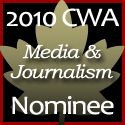 My 'Joe Canadian' selection was an easy choice today because it defines why diversity in Canada is so important.
My 'Joe Canadian' selection was an easy choice today because it defines why diversity in Canada is so important.Mr. Singh has just landed a job announcing play by play for Hockey Night in Canada, in the Punjabi language. This is an amazing symbol of what a wonderful diverse country this is, taking a national symbol and defining if for all Canadians.
Jason Kenney is so wrong about multiculturalism.
Punjabi night in Canada
Joe O'Connor, National Post
November 07, 2009
His father drove a truck and his mother worked in a bottling factory. Money was tight and small luxuries - such as a pair of squeaky new white running shoes with the coolest blue Velcro strap Parminder Singh had ever seen - were items to be treasured. And guarded with your life.
But by then, hockey had already taken over Singh's life. He was nine years old and in love with a sport that was not even a sport where he came from in India. All he wanted to do was play shinny with his multi-ethnic stew of pals in a poor corner of northeast Toronto.
And all he wanted to be was like the Toronto Maple Leafs he saw on Hockey Night in Canada every Saturday night. It did not matter that he had a turban on his head, when none of the Leafs did, just so long as he could pick the corners with the puck and say the magic words, "He shoots, he scores!"
"We played a lot of shinny," Singh says. "We had no equipment, no goalies, and I had no hockey gloves, just regular gloves. I remember being with my friends one Sunday afternoon skate at John Booth Arena. I left my shoes underneath the stands. They were almost brand new. When I got back they were gone, and I couldn't call my parents to tell them I lost my shoes, so I walked home in my skates. I was trying to hide this fact, and then they found out I lost my shoes, and they didn't want me to go skating again.
"From there, it kind of spiralled right down to where I had no hockey career."
It is 19 years later. Singh is wearing polished black dress shoes and pinstriped grey flannel pants, sitting in a Tim Hortons and laughing about the brief rise and fall of a Sikh shinny legend.
There is an irony to it, after all, since the kid with the turban on his head who wanted to grow up to be like the Leafs on TV is now working for Hockey Night in Canada as a play-by-play man calling Leafs games in Punjabi, a language no Leaf - past or present - would understand.
To CBC, the Punjabi broadcasts, which debuted during the final round of the 2008 playoffs and air on several satellite channels, represent an intriguing pilot project. Joel Darling, the network's head of sports production, sees them as a way to tap into a new audience and envisions a future where, perhaps, HNIC goes global in its scope, beaming out broadcasts to China - in Mandarin and Cantonese - to India in Punjabi, and to other far flung corners where the frozen game has no natural roots and English and French are not the official languages.
"It is a bit of outreach for us," Darling says. "We found that Parminder and [play-by-play partner] Harnarayan [Singh - no relation] have really struck a chord with the community. A lot of feedback has been positive, though I think it is safe to say that it is still a work in progress."
For the Singhs, Punjabi night in Canada is something more. Hockey is a birthright for Canadians and is often defined as "our game." But what does that mean 10 years into the 21st Century? We are not the same nation Foster Hewitt knew. More than 40% of the population in the Toronto region - a sprawling area encompassing some seven million people, including almost 200,000 Punjabi speakers - are immigrants. (Punjabi is ranked fourth among languages spoken in Canada behind English, French and Chinese). The faces of the NHL players might still be overwhelmingly white, but white it is not the colour of the country Parminder Singh grew up in.
"I want to expand the definition of ‘our,' " he says. "If hockey is truly our game, then I think it is a mosaic game. Who are Canadians? Hockey is not just your typical white family anymore, and so to claim that it is our game, and be accurate, the game needs to make inroads into the ethnic communities."
It will not be easy. There is a cultural divide to bridge between hockey and new Canadians with soccer, cricket, basketball, badminton and other sports already in their blood. There is also simple economics.
Parminder Singh's parents could not afford to buy him proper hockey gloves. Today's immigrant families face equipment costs and prohibitive league fees, an issue that cuts both ways with many leagues facing static or falling player participation rates.
John Kelloway is president of the Scarborough Hockey Association in Toronto's east end. At its peak, in the 1970s, the league had 10,000 players. It now has 3,000. Kelloway estimates no more than 5% of that number is a visible minority.
"New Canadians don't have a lot of money," he says. "So they are not going to spend it playing hockey. It costs them $1,000 to play hockey, and that's just for house league."
But even after his brief playing career ended, Parminder Singh still loved the game. He was not the only one in his household who did. His father, Amirjit, spoke some English, though not well, and his grandfather, Kartar, did not speak any at all. But on Saturday night the three generations congregated in front of the television. (Unfortunately, under Jason Kenney's new rules these men would not even be allowed to enter Canada. This is who we are now unless we start fighting back)
"I would translate the games for them, let them know what is going on, let them know the standings, and we could always share our equal frustrations with the Leafs," Singh says. "Hockey was a bonding experience for me. It was the one thing we all enjoyed - me in English - and them as a sport. I didn't like the Punjabi programs that were on TV. And they didn't like the English programs I watched. But we all liked hockey."
Hockey, oddly enough, was a natural fit for a Punjabi audience. Kabaddi is a popular Punjabi sport, best explained as tag, with some wrestling mixed in. It is an aggressive, physical game. Field hockey is also hugely popular in India, with the Punjab acting as a player factory for the national team.
Kabbadi plus field hockey did not exactly add up to ice hockey. But it did bring Singh's family together - and closer to a traditional Canadian cultural institution - and he says his story is not unique. Harnarayan Singh, 25, also tells of a Sikh family bonding over the good old hockey game. His tale is set in Brooks, Alta., a small town a few hours southeast of Calgary, where his parents were teachers and his upbringing middle-class.
"My family was the only visible minority, let alone the only family wearing turbans," he says. "Brooks has the largest meat packing plant in North America and we were vegetarian. It was quite the setting."
Harnarayan Singh has three older siblings. He says they encountered some racism at school. By the time he arrived on the scene, the family's roots in Brooks were sunk deep and his childhood was trouble-free and full of road- and floor-hockey games, and talk of Wayne Gretzky's latest feats.
"Hockey was the thing that gave students a sense of camaraderie," he says. "We talked about it all the time and to my friends, it didn't matter that I looked different or I had a turban, because when we talked, our interests met in hockey."
Talking hockey, as a Punjabi hockey broadcasters, does not pay the bills, although the pair could get a slight boost if they reach an agreement to apply their talents to CBC's Toronto Raptors telecasts. In the meantime, Parminder Singh hosts a weekly health program on Punjabi television and works as a fundraiser at a hospital. Harnarayan is a CBC reporter in Calgary, with a mortgage brokerage business on the side. Neither man suspects his growing celebrity in the Sikh community has anything to do with his day job.
"We are getting a fan following," says Parminder, who has been told HNIP has drawn close to 100,000 viewers. "It's almost like a rock star status."
Parminder Singh is humbled by the attention. Strangers approach and thank him for what he has done. Thank him for being a voice on a Saturday night that speaks to Punjabi households that have a foot in India, and a future in Canada - where hockey is their game - and where a Sikh shinny legend is preparing to revive his career.
"I bought skates," Parminder Singh says. "We are probably going to start playing shinny again soon."
I love that phrase. 'A foot in India, and a future in Canada.'
So his name is Parminder and HE IS CANADIAN!



No comments:
Post a Comment